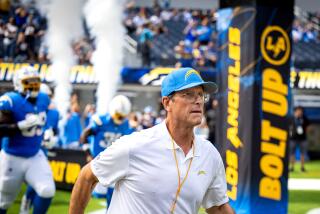Bavaro’s Performance Will Be a Key Factor for Giants
EAST RUTHERFORD, N.J. — It’s second down and the New York Giants are at their 43-yard line when Phil Simms drops back to pass.
Tight end Mark Bavaro is open underneath the Cleveland Browns’ zone. Simms delivers the ball and Bavaro lowers his left shoulder into Browns’ safety Keith Bostic, driving Bostic back two yards before he is brought down. An 8-yard gain and a first down at Cleveland’s 49.
If anyone other than Bavaro had caught the ball, the sparse crowd of 33,148 at Giants Stadium for the final preseason game would have acknowledged the play with a smattering of applause. But because it was Bavaro -- the former all-Pro trying to recover from a knee injury he suffered more than 11 months ago -- they celebrated as if the catch had led to a game-winning touchdown, not merely a first down.
Even casual fans recognize the impact Bavaro has on the Giants.
Bavaro, who tore the posterior cruciate ligament in his left knee Oct. 22, is one of a handful of players whose performance level remains suspect for the opener Sunday against the Philadelphia Eagles.
The Giants’ preseason was affected by the large number of holdouts. The offensive line has struggled partly because it couldn’t practice against the starting defensive line until Tuesday. The pass rush wasn’t a factor largely because Leonard Marshall signed a contract only a week ago and Lawrence Taylor did not sign until Wednesday. Cornerback Mark Collins has practiced only two weeks and has a bruised heel.
The defense, once without six starters, should have suffered the most. But the Giants made adjustments, using Pepper Johnson and Johnie Cooks to compensate for Taylor’s absence, and the emergence of Everson Walls and Reyna Thompson has made the secondary stronger.
It’s the direction of the offense that remains in doubt. Bavaro’s health is the answer to almost all the questions.
He doesn’t even have to be 100 percent.
“If Mark Bavaro is able to play at, say, 90 percent of his level, then I do feel we have a chance to be a better offensive team than we have been in the past,” Coach Bill Parcells said.
The Giants went 12-4 last season though Bavaro missed the final nine games. But the offense certainly wasn’t the same.
The offense retrenched, relying more on the running game centered around the between-the-tackles efforts of Ottis Anderson. The Giants were able to overpower some teams, but when they were forced to throw against the San Francisco 49ers, Los Angeles Rams and Eagles, the offense broke down.
The before-and-after numbers illustrate Bavaro’s importance. With Bavaro the Giants averaged 25.83 points a game, 19.3 without him. The running attack (134.0 yards a game with Bavaro, 108.5 without) and passing game (212.33 with, 180.6 without) were hurt almost equally.
“We went back to being predictable and I think he (Parcells) knows it’s time for a change,” wide receiver Lionel Manuel said. “We have a lot of young guys with a lot of talent, especially at running back, and we have to get them the ball.”
“But we need him (Bavaro). We need him. His presence helps, just knowing he’s out there helps.”
That’s why Bavaro’s every move was scrutinized in preseason and magnified by the media.
Skipping an afternoon session was a headline. Catching a pass in a simulated scrimmage was a lead story. Putting a bag of ice on his left knee was noteworthy.
Under Parcells the tight end has always been a big part of the offense. But Bavaro can divide a defense when he goes downfield, creating openings for a wide receiver or back coming out of the backfield.
“We did throw the ball, even when he wasn’t here and we had Zeke (Mowatt),” offensive coordinator Ron Erhardt said. “They’d catch 50, 60, 70 passes a year. It’s the design of the offense. Getting an outlet receiver and getting the ball downfield to three people. He was a force for us.
“He adds a dimension that relieves the pressure from the running backs and the wide receivers. He’s the tight end everyone would like to have.”
There is more depth at defensive back and the nickel package, with Walls playing safety and Thompson and Greg Jackson as the extra backs, has been more effective even without the benefit of a pass rush.
Left end Eric Dorsey is back after missing the final 14 games last season with a broken metatarsal bone in his foot. Nose tackle Erik Howard is entering his second season as a starter.
Carl Banks has had an outstanding preseason, elevating his play to a higher level and providing the defensive spark that usually came from Taylor. Defensive coordinator Bill Belichick will use various players and diversify their placement to generate a pass rush, using Johnson and occasionally Banks in Taylor’s role and blitzing an inside linebacker more often. Now that Taylor is back, he may be used initially on passing downs.
The Giants didn’t face an NFC opponent in preseason, but four touchdowns allowed in four games isn’t bad against any competition.
To beat the top teams in the league, the Giants know they must throw the ball more often. There has been little indication in preseason of a more open approach on offense.
But Parcells has been pestering the wide receivers all preseason, saying he’d pass if they’d give him a reason to. The breakaway talents of David Meggett and Rodney Hampton also would be better served in a passing attack.
More to Read
Go beyond the scoreboard
Get the latest on L.A.'s teams in the daily Sports Report newsletter.
You may occasionally receive promotional content from the Los Angeles Times.










